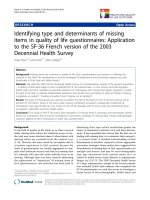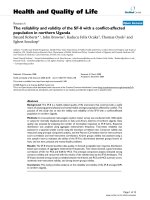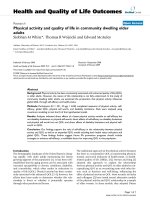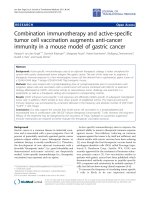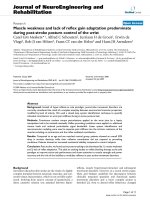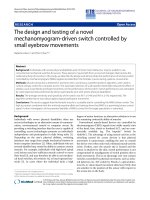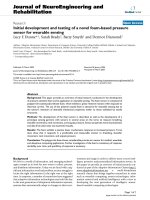báo cáo hóa học:"Clinical presentation and aetiologies of acute or complicated headache among HIV-seropositive patients in a Ugandan clinic" ppt
Bạn đang xem bản rút gọn của tài liệu. Xem và tải ngay bản đầy đủ của tài liệu tại đây (235.21 KB, 8 trang )
BioMed Central
Page 1 of 8
(page number not for citation purposes)
Journal of the International AIDS
Society
Open Access
Research
Clinical presentation and aetiologies of acute or complicated
headache among HIV-seropositive patients in a Ugandan clinic
Michael Katwere
1
, Andrew Kambugu
1
, Theresa Piloya
1
, Matthew Wong
2
,
Brett Hendel-Paterson
3
, Merle A Sande
4
, Allan Ronald
5
, Elly Katabira
1
,
Edward M Were
8
, Joris Menten
6
and Robert Colebunders*
6,7
Address:
1
Adult HIV Clinic, Infectious Diseases Institute, Makerere University, Kampala, Uganda,
2
Department of Neurology, University of
Virginia, Charlottesville, USA,
3
Department of Medicine, University of Minnesota, USA,
4
Faculty of Medicine, University of Washington, USA,
5
Department of Internal Medicine, University of Manitoba, Canada,
6
Department of Clinical Sciences, Institute of Tropical Medicine, Antwerp,
Belgium,
7
Faculty of Medicine, University of Antwerp, Belgium and
8
Uganda AIDS Commission, Kampala, Uganda
Email: Michael Katwere - ; Andrew Kambugu - ; Theresa Piloya - ;
Matthew Wong - ; Brett Hendel-Paterson - ; ;
Allan Ronald - ; Elly Katabira - ; Edward M Were - ;
Joris Menten - ; Robert Colebunders* -
* Corresponding author
Abstract
Background: We set out to define the relative prevalence and common presentations of the
various aetiologies of headache within an ambulant HIV-seropositive adult population in Kampala,
Uganda.
Methods: We conducted a prospective study of adult HIV-1-seropositive ambulatory patients
consecutively presenting with new onset headaches. Patients were classified as focal-febrile, focal-
afebrile, non-focal-febrile or non-focal-afebrile, depending on presence or absence of fever and
localizing neurological signs. Further management followed along a pre-defined diagnostic algorithm
to an endpoint of a diagnosis. We assessed outcomes during four months of follow up.
Results: One hundred and eighty patients were enrolled (72% women). Most subjects presented
at WHO clinical stages III and IV of HIV disease, with a median Karnofsky performance rating of
70% (IQR 60-80).
The most common diagnoses were cryptococcal meningitis (28%, n = 50) and bacterial sinusitis
(31%, n = 56). Less frequent diagnoses included cerebral toxoplasmosis (4%, n = 7), and
tuberculous meningitis (4%, n = 7). Thirty-two (18%) had other diagnoses (malaria, bacteraemia,
etc.). No aetiology could be elucidated in 28 persons (15%). Overall mortality was 13.3% (24 of
180) after four months of follow up. Those without an established headache aetiology had good
clinical outcomes, with only one death (4% mortality), and 86% were ambulatory at four months.
Conclusion: In an African HIV-infected ambulatory population presenting with new onset
headache, aetiology was found in at least 70%. Cryptococcal meningitis and sinusitis accounted for
more than half of the cases.
Published: 19 September 2009
Journal of the International AIDS Society 2009, 12:21 doi:10.1186/1758-2652-12-21
Received: 6 November 2008
Accepted: 19 September 2009
This article is available from: />© 2009 Katwere et al; licensee BioMed Central Ltd.
This is an Open Access article distributed under the terms of the Creative Commons Attribution License ( />),
which permits unrestricted use, distribution, and reproduction in any medium, provided the original work is properly cited.
Journal of the International AIDS Society 2009, 12:21 />Page 2 of 8
(page number not for citation purposes)
Background
In the industrialized world, headache is a common com-
plaint amongst both HIV-negative and HIV-positive indi-
viduals. In HIV-negative patients, the cause of headache is
rarely secondary to significant intracranial pathology [1-
3], but in HIV-positive patients, the risk of a secondary
"serious" cause of headache is much higher, especially in
those who are immunocompromised. In this group, the
frequency of "serious" aetiologies depends on the clinical
setting, with frequencies ranging from 4% to 82% [4,5].
The primary diagnostic procedure for headache in HIV-
positive subjects is neuroimaging [6], with some experts
recommending computerized tomography (CT) or mag-
netic resonance imaging in all HIV-positive patients with
headache [7]. This presents a unique challenge to the care
of HIV-positive patients in sub-Saharan Africa, where
access to diagnostic neuroradiologic expertise and equip-
ment is severely limited [8,9].
A study from South Africa noted that most patients with
advanced AIDS complained of pain, and 42% of these had
headache as a major pain site [10]. To our knowledge, no
studies to date have been done to estimate the relative fre-
quencies of the various aetiologies of headache in an HIV
population in sub-Saharan Africa.
The purpose of this study was to determine these relative
frequencies and their associated clinical presentations in
an ambulatory HIV-positive population in Kampala,
Uganda.
In particular we wanted to determine if there were ele-
ments in the clinical presentation that could allow a clini-
cian to differentiate a headache secondary to a "serious"
cause from one secondary to a "benign" cause. The identi-
fication of such elements may allow more efficient use of
constrained resources, such as neuro-imaging and other
expensive diagnostic tests.
Methods
The study was conducted in the Adult Infectious Diseases
Clinic (Adult IDC) in Kampala, Uganda. The Adult IDC is
a specialized semi-autonomous section of the Outpa-
tients' Department of the Mulago National Referral Hos-
pital. It is located in an urban setting, with a catchment
area of at least three million people in and around the city
of Kampala. It is a referral centre for HIV-infected adults at
primary, secondary and tertiary levels of care. The clinic
receives referrals from HIV/AIDS care centres situated out-
side Kampala in all the five regions of Uganda.
As of March 2004, the clinic had about 10,000 HIV-
infected adults in care (about 65% of them being female).
More than 50% of the patients were at WHO HIV clinical
stages III and IV at the time of recruitment into care, with
an antiretroviral therapy (ART) coverage of about 30%.
Patients who need in-patient clinical care are referred to
the Mulago Hospital in-patient medical wards upon
assessment and initial resuscitation within the clinic.
The study was performed during a 12-month period from
March 2004 to February 2005. All patients with headache
as one of their main complaints during the study period
were consecutively referred to one of two study physi-
cians.
In order to be included in the study, subjects had to have
a positive ELISA HIV-1 test and a positive confirmatory
Western blot HIV-1 test. Individuals were excluded if they
were younger than 18 years of age.
They were eligible for the study if one of their main com-
plaints was a headache, and if it was: their first headache;
different in character from previous headaches; the worst
headache they ever experienced; or a persistent headache
(more than 72 hours) despite using measures that previ-
ously relieved their headache.
In addition, they were included in the study if their head-
ache was accompanied by fever (axillary temperature
greater than 37.5 degrees Celsius), vomiting, new or
increased frequency of seizures, altered mental state, neck
stiffness, or any new focal neurologic symptom or sign.
Medical officers collected information on demographics,
history of the present illness, neurologic symptoms, past
medical and medication history, and functional status.
Patients were asked to score the severity of their headache
using a scale from 1 to 10. In addition, all study partici-
pants had a general medical and neurologic examination.
All this information was recorded on standardized case
report forms.
The aetiology of each subjects' headache was diagnosed
using standardized criteria established before the study
commenced; these are listed below (Table 1). Lumbar
puncture and cerebrospinal fluid examination were per-
formed for all enrolled subjects who did not have a focal
neurological deficit and who did not meet the case defini-
tion of bacterial sinusitis (see Table 1).
Patients' functional status was rated using the Karnofsky
Performance scale shown here:
Percent (%) Description
100 Normal; no complaints; no evidence of disease.
Journal of the International AIDS Society 2009, 12:21 />Page 3 of 8
(page number not for citation purposes)
90 Able to carry on normal activity; minor signs or symp-
toms of disease.
80 Normal activity with effort; some signs or symptoms
of disease.
70 Cares for self; unable to carry on normal activity or to
do active work.
60 Requires occasional assistance, but is able to care for
most of one's needs.
50 Requires considerable assistance and frequent medi-
cal care.
40 Disabled; requires special care and assistance.
30 Severely disabled; hospitalization indicated although
death not imminent.
20 Very sick; hospitalization necessary; active, support-
ive treatment necessary.
10 Moribund, fatal processes progressing rapidly.
0 Dead
Patients were classified as focal-febrile, focal-afebrile,
non-focal-febrile or non-focal-afebrile depending on pres-
ence or absence of localizing neurological signs and pres-
ence or absence of pyrexia. Further workup followed
along a predefined study workup plan, to an endpoint of
a diagnosis.
CT scanning was only performed in the following scenar-
ios: (A) patients with a focal neurological deficit that did
not improve within 10 days of empiric toxoplasmosis
therapy; (B) patients with a persistent headache after a
standardised workup and treatment; or (C) patients
whose comprehensive diagnostic workup did not reveal a
diagnosis for their headache.
Patients received appropriate clinical management, and
were followed by the study physicians until four months
post-diagnosis or death. The patients' investigations and
management were paid for by the study and by the Adult
IDC. At the start of the study, patients had to pay for their
ART themselves, but from July 2004, donor programmes
began to provide access for many of the study participants.
Prevalences of the aetiologies of headaches were esti-
mated together with 95% confidence intervals, calculated
using Wilson's score method. The association between
possible predictors and each of the most common diag-
noses was assessed using Fisher's Exact test. Predictors
associated with a "serious diagnosis" (defined as crypto-
coccal meningitis, tuberculous meningitis or cerebral tox-
oplasmosis) were assessed using multiple logistic
regression models.
Variables significantly associated (p-value ≤ 0.050) were
entered in a logistic regression model followed by back-
Table 1: Diagnostic criteria utilised in the study
Diagnosis Case definition
Cryptococcal meningitis Presence of Cryptococcus in the cerebrospinal fluid (CSF) by India ink examination, CSF fungal culture, or positive
serum cryptococcal antigen (CRAG) test.
Cerebral toxoplasmosis Headache accompanied by a focal neurological deficit, with clinical improvement on empiric cotrimoxazole therapy
within 14 days of initiation. A positive CT of the brain revealing characteristic ring-enhancing lesions was not
required.
Bacterial sinusitis Clinical symptoms and signs (rhinorrhoea, nasal stuffiness, headache worse when bending over, frontal or maxillary
sinus pain, and tenderness on percussion), with or without air fluid levels on skull film, and response to antibiotic
treatment.
Tuberculous meningitis Mycobacterium tuberculosis demonstrated in CSF by Ziehl-Neelsen staining and/or mycobacterial culture
(Loewenstein-Jensen culture medium); or mycobacterium tuberculosis not demonstrated in the CSF, but: (A) CSF
findings compatible with CSF protein >60 g/dL, and >200 cells/mm
3
with lymphocytic predominance; (B) evidence
of extra central nervous system tuberculosis; (C) exclusion of other aetiologies of meningitis; and (D) positive
response to anti-tuberculous therapy
Viral meningitis On the basis of mild-moderate CSF pleocytosis (<100 leukocytes/ml) and moderately elevated protein in CSF (40-
150 g/dL) with negative CSF fungal/bacterial cultures, negative Ziehl-Neelsen and gram stains of CSF, negative
serum CRAG and exclusion of tuberculosis at other sites.
Journal of the International AIDS Society 2009, 12:21 />Page 4 of 8
(page number not for citation purposes)
ward elimination removing variables from the model at
5% significance using likelihood ratio tests. All statistical
analyses were performed using SAS 9.1 (SAS Institute Inc.,
Cary, NC, USA) and R 2.6 (R Foundation for Statistical
Computing, Vienna, Austria).
The study was approved by the local research ethics com-
mittee and by the Uganda National Council for Science
and Technology. Written informed consent was obtained
from all individuals in the study.
Results
During the study period (March 2004 to February 2005),
273 persons presented with headaches and were referred
for study screening. We excluded 86 subjects (31.5%) who
did not meet the study inclusion criteria (one was HIV
seronegative on confirmatory testing; 85 presented with
headaches that did not meet the enrolment criteria
described in the Methods section). Seven patients meeting
study criteria declined consent mainly due to personal
and cultural fears regarding the use of lumbar puncture as
a potential investigation tool. Finally, 180 subjects, who
met the study eligibility criteria, were enrolled.
Patients' characteristics at the time of enrolment are pre-
sented in Table 2. Women accounted for 72% of the
enrolled subjects, which is consistent with the demo-
graphics of the clinic. A generalized or frontal headache
was reported by 78% of the study participants with a
median severity score of eight. The majority presented
with advanced HIV, with 78% at WHO HIV clinical stages
III or IV. The median Karnofsky performance rating was
70 (IQR 60-80).
Less than 20% of the study subjects presented with either
fever or focal neurological signs (Table 2).
Almost 60% of the headache presentations were attribut-
able either to Cryptococcus neoformans meningitis or to
presumed bacterial sinusitis (Table 3). The clinical fea-
tures of the main aetiological diagnoses are shown in
Table 4. Thirty two (18%) subjects presented with features
of meningeal irritation and/or raised intracranial pres-
sure. Twenty-five (78%) of these 32 patients were diag-
nosed with cryptococcal meningitis. Cryptococcal
meningitis was diagnosed in 10 (77%) of 13 patients with
neck stiffness; in six (67%) of nine patients with a positive
Kernig's sign and in seven (70%) of 10 patients with pap-
illoedema at baseline. Two subjects subsequently diag-
nosed with cryptococcal meningitis did not present with
features of meningeal irritation at enrolment.
Of the 50 patients with cryptococcal meningitis, 38 (76%)
presented with an initial episode of cryptococcal infec-
tion, and 12 (24%) presented with either a relapse of the
disease or an immune reconstitution event secondary to
antiretroviral treatment.
Thirty six (52%) were managed without hospitalization
with oral fluconazole; of these, 12 (33%) died. Of the 14
(28%) who were admitted to hospital for amphotericin B
treatment, eight (57%) died of either cryptococcal disease
or complications of therapy. Of the 50 patients with cryp-
tococcal meningitis, only 17 (34%) received ART. Four-
teen patients with cryptococcal meningitis died before
they received ART, and six died after initiating ART.
Fifteen percent of the headaches could not be classified
aetiologically. These headaches generally improved on
oral analgesics; but recurrent headache of mild to moder-
ate severity during follow up was reported. One patient
from this group died from presumed ART-related immune
reconstitution syndrome during the four months of fol-
low up. Two patients were lost to follow up, the rest
(86%) were ambulant, with a Karnofsky performance sta-
tus greater than 80% at four months of follow up.
Overall, mortality after four months of follow up was
13.3% (24 of 180). Only six (25%) of the 24 study
patients who died were on antiretroviral treatment.
Table 2: Patients' characteristics at study enrolment
Patient characteristics n (%)
Total N 180
Sex
†
Men: n (%) 51 (28)
Women: n (%) 128 (72)
Age: median (IQR) 35 (30-41)
Location
†
Frontal: n (%) 68 (39)
Temporal: n (%) 27 (15)
Occipital: n (%) 9 (5)
Vertex: n (%) 2 (1)
Generalized: n (%) 69 (39)
Headache score
†
: median (IQR) 8 (6-10)
Headache duration (days)
†
: median (IQR) 10 (5-21)
WHO stage
†
:
I or II: n (%) 38 (21)
III: n (%) 73 (41)
IV: n (%) 66 (37)
Patient on ART: n (%) 53 (29)
Karnofsky performance score
†
: median (IQR) 70 (60-80)
CD4 count
†
: median (IQR) 108 (20-239)
Workup classification
†
:
Focal/febrile 3 (2)
Non-focal/febrile 19 (11)
Focal/afebrile 11 (6)
Non-focal/afebrile 144 (81)
†
Number of patients with data missing: gender (1), location (5),
headache score (6), headache duration (1), WHO stage (3),
Karnofsky performance score (4), CD4 (10), workup classification (3).
Journal of the International AIDS Society 2009, 12:21 />Page 5 of 8
(page number not for citation purposes)
In the univariate analysis, the following variables were sig-
nificantly associated with a diagnosis of cryptococcal
meningitis (Table 4): male gender (p = 0.040), a general-
ised headache (p = 0.008), WHO stage (p < 0.001), CD4
cell count below 200 cells/ml (p < 0.001), change in head
position worsens headache (p < 0.001), neck stiffness (p
< 0.001), Kernig's sign (p = 0.015), and papilloedema (p
= 0.005).
The same variables, apart from location of headache, were
associated with a diagnosis of a "serious condition" (that
is, cryptococcal meningitis, tuberculous meningitis or cer-
ebral toxoplasmosis). Multiple logistic regression con-
firmed male gender, CD4 cell count less than 200 cells/
ml, change in head position worsens headache, and neck
stiffness as significant independent predictors of a diagno-
sis of cryptococcal meningitis; and male gender, CD4 cell
count less than 200 cells/ml, change in head position
worsens headache, neck stiffness, and WHO disease stage
as significant independent predictors of diagnosis of a
"serious condition" (Table 5).
Discussion
About 60% of the headache presentations in this series of
patients were attributable either to cryptococcal meningi-
tis or to sinusitis. Not unexpectedly, clinically severe head-
ache with CD4 counts of below 200 cells/mm
3
was more
likely to be due to cryptococcal meningitis; for those with
CD4 counts of above 200 cells/mm
3
, severe headache was
more likely to be due to sinusitis. The diagnosis of sinusi-
tis carried a good prognosis, usually with rapid improve-
ment with antimicrobial treatment and few relapses
despite a study population with advanced HIV disease.
The overwhelming predominance of sinusitis in females is
unexplained. Perhaps they were more likely to present to
the clinic with less severe headache than men. Sinusitis is
a major unappreciated challenge in HIV patients. Its fre-
quency was not anticipated, but it has been noted in other
studies [11]. However, we also note that our case defini-
tion for bacterial sinusitis does not sufficiently rule out a
migrainous headache. Therefore it is possible that some of
the cases that were diagnosed and managed as sinusitis
were attributable to migraine or migrainous headache.
More than 90% of headaches due to cryptococcal menin-
gitis, tuberculous meningitis and toxoplasmosis were
exacerbated by changes in head position. This phenome-
non is presumably due to elevations of intracranial pres-
sure that are associated with these conditions.
We noted that headache duration, mode of onset of the
headache (insidious or acute), and headache severity did
not correlate with a diagnosis of cryptococcal meningitis.
Neck stiffness and a CD4 cell count of below 200/mm
3
predicted cryptococcal disease. However additional inves-
tigations, particularly cerebrospinal fluid analysis and
serum CRAG test, are needed for a definitive diagnosis.
Table 3: Number and percentage of patients by headache aetiology
Diagnosis N Percentage (95% confidence interval)
Cryptococcal meningitis 50 28 (22-35)
Bacterial sinusitis 56 31 (24-38)
Cerebral toxoplasmosis 7 4 (2-8)
Tuberculous (TB) meningitis 7 4 (2-8)
Other: 32 18 (13-24)
Viral meningitis 6 3 (2-7)
Malaria 5 3 (1 6)
TB adenitis/abdominal TB 3 2 (1-5)
Depression/anxiety 2 1 (0-4)
CMV retinitis 2 1 (0-4)
Drug-induced headache 2 1 (0-4)
Partially treated bacterial meningitis 1 1 (0-3)
Otitis media 1 1 (0-3)
Tonsillitis 1 1 (0-3)
Aphthous ulcer 1 1 (0-3)
Central retinal vein occlusion 1 1 (0-3)
HIV associated nephropathy 1 1 (0-3)
Urinary tract infection 1 1 (0-3)
Herpes zoster ophthalmicus 1 1 (0-3)
Bell's palsy 1 1 (0-3)
Staphylococcus aureus bacteraemia 1 1 (0-3)
Cerebro-vascular accident 1 1 (0-3)
Hepatitis 1 1 (0-3)
Unknown 28 16 (11-22)
Journal of the International AIDS Society 2009, 12:21 />Page 6 of 8
(page number not for citation purposes)
Table 4: Clinical features associated with the main diagnoses (number of patients by characteristic and main diagnosis)
CM
(N = 50)
Sinusitis
(N = 56)
Toxoplasmosis
(N = 7)
TBM
(N = 7)
Other
(N = 32)
Unknown
(N = 28)
Gender
Male 20 4 4 3 8 12
Female 29 52 3 4 24 16
p-value 0.040 < 0.001 0.103 0.408 0.829 0.073
Location of headache:
Frontal 13 34 1 5 6 9
Temporal 45 2 18 7
Occipital 52 0 02 0
Vertex 02 0 00 0
Generalised 27 12 4 1 15 10
p-value 0.008 < 0.001 0.461 0.392 0.077 0.400
Headache duration:
0-13 days 25 32 4 4 14 13
14-27 days 12 9 1 1 15 7
>28 days 12 15 2 2 3 8
p-value 1.000 0.163 0.888 0.888 0.006 0.712
WHO stage:
I or II 317 0 09 9
III 16 24 2 4 15 12
IV 30 14 5 3 8 6
p-value < 0.001 0.041 0.129 0.480 0.240 0.133
CD4 count:
<50 31 11 1 2 14 8
50-199 15 18 3 3 6 6
≥ 200 124 1 211 13
p-value < 0.001 0.001 0.451 0.801 0.376 0.115
Workup classification:
Focal/febrile 10 0 01 1
Non-focal/febrile 55 1 07 1
Focal/afebrile 30 4 13 0
Non-focal/afebrile 39 50 2 6 21 26
p-value 1.000 0.048 < 0.001 0.550 0.040 0.182
Change in head position worsens headache:
No 212 3 19 10
Yes 47 42 4 6 22 18
p-value < 0.001 0.842 0.162 1.000 0.232 0.046
Meningeal signs and/or raised intracranial pressure:
Neck stiffness 10 0 0 2 1 0
p-value < 0.001 0.010 1.000 0.084 0.468 0.222
Positive Kernig's sign 60 0 11 1
p-value 0.015 0.059 1.000 0.311 1.000 1.000
Papilloedema 71 0 10 1
p-value 0.005 0.175 1.000 0.277 0.210 1.000
New onset headache:
No 35 1 01 0
Yes 46 49 6 7 30 26
p-value 1.000 0.288 0.344 1.000 1.000 0.362
Worst headache in patient's lifetime:
No 11 16 1 1 6 8
Yes 38 39 6 6 26 20
p-value 0.846 0.345 1.000 1.000 0.501 0.631
See note for Table 2 for numbers of patients with missing data.
P-values from Fisher's Exact test comparing those with and without the diagnosis by possible predictor.
CM: Cryptococcal meningitis; TBM: Tuberculous meningitis.
Journal of the International AIDS Society 2009, 12:21 />Page 7 of 8
(page number not for citation purposes)
Eighteen (75%) of the 24 deaths in the study population
were attributable to cryptococcal meningitis.
In 15% of the cases, no aetiology was discovered after full
diagnostic workup. These patients generally improved on
analgesic therapy. There were no clinical parameters from
our analysis that could clearly predict an "unknown" aeti-
ology. Fortunately, all of the patients, except one, with an
unknown aetiology for their headaches improved with
supportive therapy alone.
We conclude from this that once other serious and treata-
ble causes have been ruled out by history and physical
exam, laboratory and/or imaging, it is reasonable to treat
with analgesics, reassurance and close clinical follow up.
Cerebral toxoplasmosis accounted for just less than 4% of
the headache aetiologies in our population. This was
observed despite the fact that more than 54% of persons
with HIV infection in Uganda were reported to have a pos-
itive serology for toxoplasmosis [12].
The low prevalence of cerebral toxoplasmosis in our study
population may be due to the fact that most of our HIV-
seropositive adults are initiated on co-trimoxazole proph-
ylaxis in accordance with the national guidelines for the
management of HIV in Uganda. Second, patients with cer-
ebral toxoplasmosis presenting with focal neurological
deficits may be more likely to be seen in an in-patient set-
ting.
In addition, some patients with focal neurological symp-
toms attributable to cerebral toxoplasmosis may not have
presented with headache as a major complaint. Such
patients would not have been enrolled in this study due to
the inclusion and exclusion criteria for the headache
symptom.
It is imperative to note that the diagnosis of cerebral tox-
oplasmosis was empiric, based on improvement of focal
neurological symptoms after at least 10 days of co-trimox-
azole therapy. Computerised tomography scanning was
not a requirement in the study for the diagnosis of cere-
bral toxoplasmosis. It is therefore possible that there were
alternative aetiologies for some of the subjects diagnosed
with cerebral toxoplasmosis.
Tuberculous and viral meningitides together accounted
for just less than 8% of the aetiologies of headaches. These
conditions, however, may be under-diagnosed given the
absence of definitive diagnostic kits (for instance, CSF
PCR for Epstein Barr, Herpes simplex, etc.) for the viral
meningitides and the very low sensitivity [13] of CSF
Ziehl-Neelsen staining for the diagnosis of tuberculous
meningitis.
We also noted a low prevalence of headache (of any
cause) associated with fever (less than 20% of study sub-
jects). This could be due to the fact that our patients fre-
quently utilise over-the-counter medications like non-
steroidal anti-inflammatory drugs and paracetamol to
alleviate their HIV-related ailments, like pain.
The study had a number of limitations. It was drawn from
a patient population of HIV-infected individuals regis-
tered at only one care centre. Also, many patients with
very severe headaches, neurological localizing findings or
seizures may have presented directly to the casualty
department of the hospital rather than to an out-patient
setting. It was not financially feasible to do CT scanning
Table 5: Features associated with any serious conditions (cryptococcal meningitis, cerebral toxoplasmosis or tuberculous meningitis)
Cryptococcal meningitis Serious condition
Odds ratio
(95% CI)
p-value Odds ratio
(95% CI)
p-value
Sex (male) 3.4 (1.4, 9.0) 0.011 4.0 (1.6, 10.3) 0.003
CD4
<50 47.3 (8.6, 901) < 0.001 9.4 (2.6, 46.4) 0.002
50-199 23.5 (4.1, 454) 0.004 7.5 (2.0, 37.4) 0.006
≥200 1 (Ref.) 1 (Ref.)
Change in position worsens headache 21.4 (3.9, 407) 0.005 6.3 (1.9, 26.0) 0.005
Neck stiffness 9.2 (1.8, 82.8) 0.019 32.2 (4.2, 719) 0.004
WHO stage
I & II 1 (Ref.)
III ? ? 4.2 (1.0, 24.4) 0.066
IV ? ? 6.5 (1.6, 37.6) 0.016
Note: Odds ratios, confidence intervals (95% CI) and p-values calculated from multivariate logistic regression model. All variables included in the
final multivariate model are shown. Variables considered in the step-wise procedure were: gender, headache location (Cryptococcal meningitis
only), WHO stage, CD4 cell count, change in head position worsens headache, neck stiffness, Kernig's sign and papilloedema.
Publish with BioMed Central and every
scientist can read your work free of charge
"BioMed Central will be the most significant development for
disseminating the results of biomedical research in our lifetime."
Sir Paul Nurse, Cancer Research UK
Your research papers will be:
available free of charge to the entire biomedical community
peer reviewed and published immediately upon acceptance
cited in PubMed and archived on PubMed Central
yours — you keep the copyright
Submit your manuscript here:
/>BioMedcentral
Journal of the International AIDS Society 2009, 12:21 />Page 8 of 8
(page number not for citation purposes)
for all the patients in the study. Finally, viral meningitides
and tuberculous meningitis were diagnosed by an exclu-
sion process rather than by definitive technologies, which
were not available.
Conclusion
We conclude that at least 70% of the aetiologies for new
onset and/or severe headache in a large African HIV-
infected ambulatory population can be adequately diag-
nosed in resource-limited settings; in our study, crypto-
coccal meningitis and sinusitis accounted for more than
half of these cases.
At least 80% of the diagnoses in our study were arrived at
without needing advanced imaging, which is reassuring
with regard to HIV/AIDS management in resource-con-
strained settings. Finally, headaches of unknown aetiol-
ogy have a relatively good prognosis with supportive
therapy alone, as long as more serious causes of headache
have been ruled out.
Competing interests
Each of the authors, MK, AK, TP, MW, BHP, AR, EK, EMW,
JM and RC declare that they have no competing interests
with respect to this manuscript.
MAS sadly passed away in 2008; he too did not have any
competing interests regarding the publication of this man-
uscript.
Authors' contributions
MK participated in study set up and conduct, data collec-
tion and analysis, drafting and writing of the manuscript.
AK participated in the conception of the study, study set
up and data analysis. TP participated in study conduct,
data collection, data cleaning and manuscript writing.
MW was involved in the conception of the study, data
analysis and drafting of the manuscript. BHP participated
in the drafting and reviewing of the manuscript. MAS par-
ticipated in study set up, drafting and reviewing of the
manuscript. AR participated in conception of the study,
drafting and writing of the manuscript. EK was involved in
the conception of the study and drafting of the manu-
script. EMW participated in the data analysis, drafting and
reviewing of the manuscript. JM participated in the data
analysis, reviewing and writing of the manuscript. RC par-
ticipated in the study conduct, reviewing and writing of
the manuscript. All the authors reviewed and approved
the manuscript.
Acknowledgements
We are deeply indebted to Naomi Nantamu, Alice Namudde and Fred Seb-
uuma, who worked as study nurses. We acknowledge David Boulware for
reviewing the paper and John Michael Matovu for the study data entry. We
sincerely acknowledge the Bill and Melinda Gates Foundation for the study
funding. We are grateful to the Infectious Diseases Institute, Mulago Hos-
pital and the Academic Alliance Foundation for the study support. We will
always be indebted to the trial participants who kindly participated in this
study.
References
1. Morrell DC: Symptom interpretation in general practice. JR
Coll Gen Pract 1972, 22(118):297-309.
2. Field AG, Wang E: Evaluation of the patient with nontraumatic
headache: an evidence based approach. Emerg Med Clin North
Am 1999, 17(1):127-52. ix
3. Frishberg BM: The utility of neuroimaging in the evaluation of
headache in patients with normal neurologic examinations.
Neurology 1994, 44(7):1191-1197.
4. Singer EJ, Zorilla C, Fahy-Chandon B, Chi S, Syndulko K, Tourtellotte
WW: Painful symptoms reported by ambulatory HIV-
infected men in a longitudinal study. Pain 1993, 54(1):15-19.
5. Lipton RB, Feraru ER, Weiss G, Chhabria M, Harris C, Aronow H,
Newman LC, Solomon S: Headache in HIV-1-related disorders.
Headache 1991, 31(8):518-522.
6. Graham CB III, Wippold FJ II: Headache in the HIV patient a
review with special attention to the role of imaging. Cephala-
lgia 2001, 21(3):169-174.
7. Tso EL, Todd WC, Groleau GA, Hooper FJ: Cranial computed
tomography in the emergency department evaluation of
HIV-infected patients with neurologic complaints. Ann Emerg
Med 1993, 22(7):1169-1176.
8. Jallon P: Epilepsy in developing countries. Epilepsia 1997,
38(10):1143-1151.
9. Rabinowitz DA, Pretorius ES: Postgraduate radiology training in
sub-Saharan Africa: a review of current educational
resources. Acad Radiol 2005, 12(2):224-231.
10. Norval DA: Symptoms and sites of pain experienced by AIDS
patients. S Afr Med J 2004, 94(6):450-454.
11. Shah AR, Hairston JA, Tami TA: Sinusitis in HIV: Microbiology
and Therapy. Curr Infect Dis Rep 2005, 7(3):165-169.
12. Lindstrom I, Kaddu-Mulindwa DH, Kironde F, Lindh J: Prevalence of
latent and reactivated Toxoplasma gondii parasites in HIV-
patients from Uganda. Acta Trop 2006, 100(3):218-222.
13. Portillo-Gomez L, Morris SL, Panduro A: Rapid and efficient
detection of extra-pulmonary Mycobacterium tuberculosis
by PCR analysis. Int J Tuberc Lung Dis 2000, 4(4):361-370.



